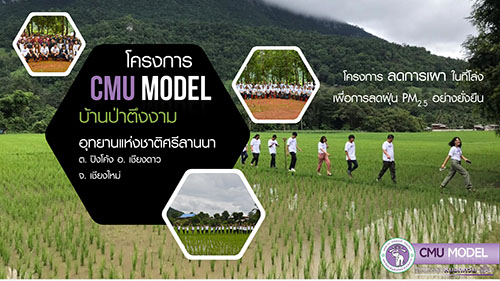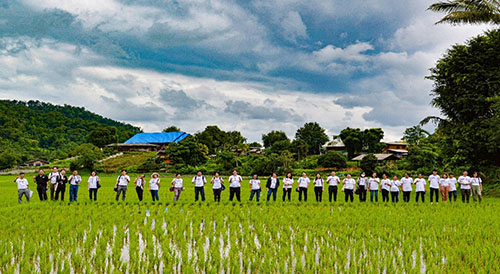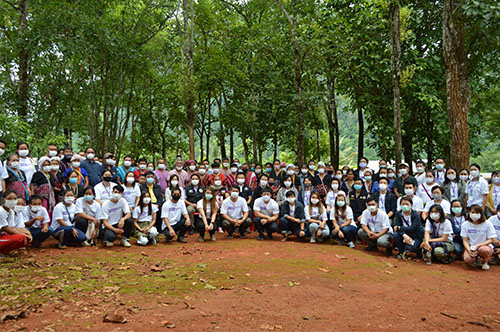The beauty of the mountainous region of Northern Thailand towards the end of the winter season and at the cusp of summer is no more. What was once a charming and renowned time for the north is, today, known as the smog season. The North falls under a pall of air pollution, trapped in the valleys and basins below.
The upper Northern Thailand has a topography akin to a wok, surrounded by mountains. Areas such as Chiang Mai, Chiang Rai, Lamphun, Nan, Phrae, Mae Hong Son, Phayao and Tak provinces are covered by a blanket of air pollution because of the burning in the open – both forest and agriculture burning. Because the topography is similar to a wok, surrounded by mountains, this makes a basin which traps air pollution and which is hard for air to escape, leading to a great amount of PM 2.5-micron air particles. This affects the health and the respiratory system of the public in the northern region.
Each year the smog season will circle back and become a problem which appears to be hard to solve, leading to the question of where the origins of the problems truly are and how to solve this problem.
Chiang Mai University, as an institution in the north of Thailand, has seen this problem and in the past the academics of the university, experts in a variety of fields, have attempted to solve this problem as per their areas of expertise. However, there has yet to be unity. Because of this the Chiang Mai University has set up a special unit named the Academic Centre for Air Pollution in Northern Thailand Chiang Mai University (AcAirCMU) in June 2019 to combine forces to solve this problem of air pollution. The unit supports data for the academics, monitors the situation of air pollution in the North of Thailand in a consistent way, disseminates information and knowledge which is correct to the public. It also studies, analyses and recommends avenues to solve this problem
The results of the practice in the past has been striking and has led to Chiang Mai University receiving the first ranking from The Times Higher Education University Impact Rankings 2021 this past April, a global performance table that assess universities against the United Nations’ Sustainable Development Goal. This ranking was in recognition of the formation of AcAirCMU, the development of the Chiang Mai Air Quality Health Index (CMAQHI) , recently Northern Thailand Air Quality Health Index (NTAQHI), which informs the public of air pollution data and eradication efforts, as well as working in cooperation with various faculties within the Chiang Mai University to eventually form the project and innovation for finding solutions to the air pollution problem. Using the knowledge and expertise of the academic sector to solve problems of the public in a targeted and effective way.

Associate Professor Dr.Somporn Chantara, Chairperson of Academic Working Group for Air Pollution Northern Thailand,
Chiang Mai University
As to the reason for the air pollution problem in the upper Northern region, Associate Professor Somporn Chantara, Chairperson of Academic Working Group for Air Pollution Northern Thailand, Chiang Mai University explains;
“First of all there is the natural factor. Because the north of Thailand is in a basin surrounded by mountains, in the smog season the ventilation of the air pollution is challenging due to the still air and low pressure of air and calm wind, creating a basin which accumulates air pollution.
Secondly, it is about the source, in particular open air burning, both in the forest and as part of the agricultural sector, traffic and air pollution crossing borders, etc. These are all dimensions which are varied and which combine to create the same problem again and again. We have tried to solve this problem at its roots by reducing the sources of air pollution. In the past the province focused on controlling burning by issuing regulations banning burning, but it has been ineffective because there is the social aspect to factor in. If local people do not cooperate, then that is the end. This means that they will secretly burn anyway which makes the situation uncontrollable and does not reduce the problem at the source. Recently a new suggestion has been made for the first 60 days of burning, the Fire Management Decision Support System (Fire-D), to support the workings of the agencies of Chiang Mai Province under the Chiang Mai war room for PM2.5 reduction.
Dr. Chakrit Chotamonsak, lecturer at the Department of Geography, Faculty of Social Sciences and Director of the Regional Centre for Climate and Environmental Studies (RCCES), is responsible for analysing atmospheric conditions three to five days in advance, and displaying the location and details of each point of fire as well as showing the status of the process of solving the problem. The centre also collects all information used in decision making of various stakeholders across the system.”
CMU Model, Project to create space to solve the air pollution problem of the north of Thailand in a sustainable way

“Why does this problem occur?” asks Associate Professor Somporn rhetorically. “This is a question which is asked every year. The truth is that this is a complex matter with many limitations which academics are trying to analyse as to why it is continues to occur.” She goes on to talk about the CMU Model, the project to create a model to solve the air pollution problem in the North of Thailand in a sustainable way, based on the knowledge generated by research by the Chiang Mai University to disseminate such knowledge and innovation, with a focus on working on-location to help the public, the highlight of this project is how it integrates the works of all stake holders and sectors from the government to the private, the public to local leaders, to truly solve this shared problem of air pollution in the North. Initially receiving support from the Prime Minister in liaising with the Department of National Parks and Wildlife Conservation, to signing an MOU for cooperation between the Chiang Mai University and the Department of National Parks and Wildlife Conservation in working on activities to develop areas of the Sri Lanna National Park, Ping Khong Sub-district, Chiang Dao District, Chiang Mai province, and Chiang Mai University to become a model for solutions of air pollution in a sustainable way.
 |  |
CMU Model team working at Baan Pa Teung Ngam, Ping Khong Sub-district, Chiang Dao District, Chiang Mai
The highlight of this project is that it uses public participation in solving problems, opening a perspective to the public to truly understand problems that communities have in their relationships with forests, especially how it affects them economically. Many communities have refused to cooperate with the government sector when it comes to burning bans, a problem which needs to be addressed directly. Chiang Mai University has therefore drawn upon the expertise and knowledge of its academics to help solve the problem both directly and indirectly so that communities can live with forests in a sustainable manner. There are meetings held to work on plans of action with villagers which will not affect the diversity of the ecosystem within the national parks along with monitoring air pollution as per situations arise. This is work done under the management of the forestry land in a participatory manner between communities, the national parks and the university in four areas;
1. Development of quality of life and the economy: encouraging the potential of communities so that businesses can participate according to local knowledge, creating local enterprises working on forest management, develop local skills for communities to have more diverse careers;
2. Environment: encouraging agroforestry and the protection and production of seedlings of indigenous plants for forest restoration;
3. Utilities: development of solar power systems and water filtering systems for the public;
4. Society and public health: providing innovation of PM2.5 protective masks for fire fighters and construction of clean rooms (PM2.5 free zone) for sensitive groups such as young children and elderly , analysis of biomarkers for air pollution so the public has more knowledge and awareness. Other activities such as planting trees in forest areas under agroforestry concept. Chiang Mai University and the Department of National Parks and Wild life Conservation and villagers are also working together to manage the use the national resources in a sustainable way to be able to reduce forest fires and reduction of air pollutant emission. In long term, less forest land will be destroyed and there will be less encroachment of land.
The success of the CMU Model at Ping Khnog Sub-district, Chiang Dao District is therefore the way to solve the air pollution problem in a sustainable way, and can become a model for learning for many communities.
Managing forest resources with participation of the local community
Promoting local products
Innovation for solving air pollution problems in a sustainable way.
The beginning of innovation often comes from the attempt to solve a problem. The variety of innovations which have emerged in solving the air pollution problem in the North of has inspired many academics to solve this problem or at least to be part of the process of innovation for a better society.
Not only are the lives of the officials who fight the fire which are threatened, but the damage to the environment is incalculable. The dangers to millions of people from the air particles themselves is also an urgent matter to address. The Geo-Informatics and Space Technology Centre (Northern Region), Department of Geography, Faculty of Sciences, Chiang Mai University (GISTNORTH) along with the Defense Technology Institute (DTI) are working on Thermal UAVS (small drone technology) to patrol at-risk forest areas, capturing images and detecting heat, acting as a warning system for authorities who can then respond efficiently and immediately. In the past this work was supported by the Doi Suthep-Pui National Park and Sri Lanna National Park to protect and control fire.
 |  |
| Drone technology for heat detection | Drone technology patrolling for fire |
The university’s Energy Research and Development Institute – Nakornping, has also focused its work on clean air, having initially developed a prototype student dormitory which is air-pollution-free, which, once implemented throughout the university can be of great benefit to students’ health as well as can be used as a model for other spaces in communities, schools, hospitals and other at-risk locations.
Student dormitory prototype at Chiang Mai University
The development of the Air Quality Index (AQI) application has also been widely received by the general public who use it to monitor air quality situations across the region. Measuring and reporting on PM 2.5 levels by the hour or by the day across the nation, the Climate Change Data Centre (CCDC) is supported by the National Research Council of Thailand in setting up the Dustboy machine which publishes its results at www.cmuccdc.org as well as the web application CMU Mobile which displays the levels of various clean air rooms within the Chiang Mai University and CMU Air Quality for the general public to access. Daily reports are also posted on the Chiang Mai University Facebook page so that the public can monitor danger levels which may affect their health during the smog season.

Measuring and reporting on PM 2.5 levels by the hour or by the day across the nation, the Climate Change Data Centre (CCDC) is supported by the National Research Council of Thailand in setting up the Dustboy machine which publishes its results at www.cmuccdc.org
The Thai Air Quality application which was developed by the Regional Centre for Climate and Environmental Studies (RCCES), Faculty of Social Sciences, Chiang Mai University, can predict air pollution levels not only in the North of Thailand, but also across the nation as well as in Cambodia, Myanmar, Laos and Vietnam, up to three days in advance.
Thai Air Quality application
One other application, CMAQHI and the quality of air for health measurement web site www.ntaqhi.info developed by the Research Institute for Health Sciences, Chiang Mai University (RIHES) focuses solely on up to date data for the residents of the North of Thailand. The public can check, real time, air pollution levels around the clock and the application provides important notices and advice including warnings so that the public may take preventative measures to protect themselves.
Lastly, there is the innovation of PM2.5 masks, developed by the Environmental Science Research Centre (ESRC), Faculty of Science, Chiang Mai University in cooperation with the Working Group for Air Pollution Northern Thailand, Chiang Mai University. The Envi Mask is a new prototype of PM2.5 masks which can be washed up to five times and is highly effective against small particles due to its removable filter. The Envi Nano+Mask takes the mask even further as it can filter out particles as small as 0.0075 microns and be reused up to twenty times. The Masqurax@CMU positive pressure mask, developed by the Department of Mechanical Engineering, Faculty of Engineering, Chiang Mai University and the Academic Working Group for Air Pollution Northern Thailand, Chiang Mai University has also been developed to filter particles as small as 1 micron and is suitable for use in firefighting efforts by rescue workers, traffic police as well as other at-risk groups.
These innovations developed by various faculties and researchers at Chiang Mai University, working in partnership with the government sector, with local communities and with the public at large, together will help solve and disperse the annual air pollution crisis in a sustainable way for healthier and better living.